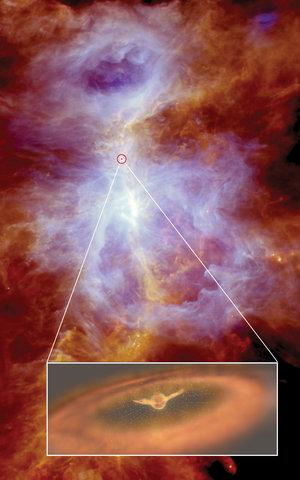

Jetting into space
Today’s NASA/ESA Hubble Space Telescope Picture of the Week peers into the dusty recesses of the nearest massive star-forming region to Earth, the Orion Nebula. Just 1300 light-years away, the Orion Nebula is visible to the naked eye below the three stars that form the ‘belt’ in the constellation Orion. The nebula is home to hundreds of newborn stars including the subject of this image: the protostars HOPS 150 and HOPS 153.
These protostars get their names from the Herschel Orion Protostar Survey, which was carried out with ESA’s Herschel Space Observatory. The object that can be seen in the upper-right corner of this image is HOPS 150: it’s a binary system, two young protostars orbiting each other. Each has a small, dusty disc of material surrounding it that it is feeding from. The dark line that cuts across the bright glow of these protostars is a cloud of gas and dust, over 2 000 times wider than the distance between Earth and the Sun, falling in on the pair of protostars. Based on the amount of infrared versus other wavelengths of light HOPS 150 is emitting, the protostars are mid-way down the path to becoming mature stars.
Extending across the left side of the image is a narrow, colourful outflow called a jet. This jet comes from the nearby protostar HOPS 153, out of frame. HOPS 153 is a significantly younger stellar object than its neighbour, still deeply embedded in its birth nebula and enshrouded by a cloud of cold, dense gas. While Hubble cannot penetrate this gas to see the protostar, the jet HOPS 153 has emitted is brightly visible as it plows into the surrounding gas and dust of the Orion Nebula.
The transition from tightly swaddled protostar to fully fledged star will dramatically affect HOPS 153’s surroundings. As gas falls onto the protostar, its jets spew material and energy into interstellar space, carving out bubbles and heating the gas. By stirring up and warming nearby gas, HOPS 153 may regulate the formation of new stars in its neighbourhood and even slow its own growth.
[Image Description: An area in the Orion nebula filled with dark, puffy clouds. On the left side a large area of clouds, crossed by a dark bar, is lit up in red and whitish colours by a protostar within. At the other side a large jet of material ejected by the protostar appears, made of thin, wispy, blue and pink clouds. A couple of foreground stars shine brightly in front of the nebula.]





